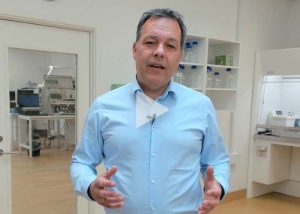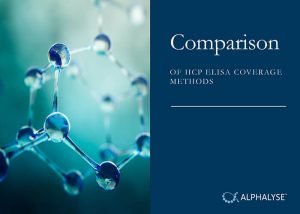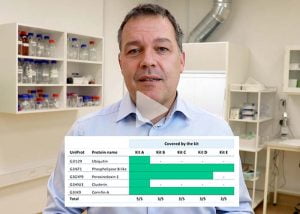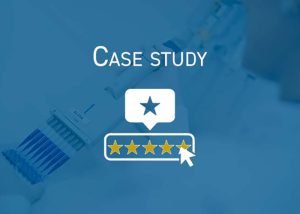Literature
Why results obtained by a new HCP-ELISA kit differ from the original
February 15 2024, by Anette Holck Draborg

Question:
I use a commercial ELISA kit to monitor Host Cell Proteins in my recombinant protein product. The supplier of the kit is now switching to a new set of reagents. The supplier says the coverage is the same, but analyzing my reference sample using the latest kit gives an entirely different result. Why?
Answer:
Bridging from one ELISA kit to another, even a new version of the same kit, is not as straightforward as it sounds.
The HCP antibodies in the two kits differ, and the ELISA standard used to determine the HCP concentration of the samples might also vary. Therefore, analyzing the same sample using each kit can give quite different results. [1, 2]
There may be several reasons for the observed differences when bridging between commercial ELISA kits for Host Cell Protein (HCP) analysis:
1. The polyclonal HCP antibodies in the two kits are not the same
HCP antibody specificity varies between ELISA kits. ELISA measures immunocaptured HCPs, and a kit's ability to capture HCPs depends on the relative amounts of HCP antibodies with affinity for individual HCPs in a given sample. Since polyclonal HCP antibodies are created by inducing immune responses in animals, abundant and/or highly immunogenic HCPs may result in a larger fraction of the polyclonal HCP antibodies recognizing these 'high responder' HCPs, while fewer antibodies are generated towards other HCPs. [3, 4, 5]
This means the HCP antibodies in an ELISA kit may capture 'high responder' HCPs disproportionately to their actual amount in a sample, so they dominate the ELISA absorbance signal. Conversely, other HCPs will saturate the too-few HCP antibodies with specific affinity for them, leaving some of the HCPs unbound and undetected. And since animals' immune systems are often variably sensitive to individual HCPs and produce different amounts of antibodies, no two ELISA kits are exactly the same.
You can learn more about high-responder HCPs and “Lucky goats” in this blog post.
2. The ELISA standard used for quantification is variable
The HCP composition of the standard supplied with an ELISA kit varies between ELISA kit vendors and may even vary between kits. Since the ELISA standard is used to prepare the standard curve for calculating each sample's overall amount of HCP, this can lead to skewed results.
An often-overlooked issue is when an ELISA standard matches the kit's HCP antibodies too well. In this case, the HCP antibodies will perfectly capture all HCPs in the ELISA standard and generate a strong absorbance signal. However, it is unlikely that an actual sample will match the ELISA antibody distribution to the same degree as the ELISA standard – particularly if the sample is complex and its HCP profile differs significantly from the ELISA standard. This will result in a much weaker absorbance signal and lead to underestimating the quantity of HCPs in the sample.
Because the HCP composition of ELISA standards is variable, using different standards can result in different measurements of HCP levels in the same sample – even with the same HCP antibodies. [6]
3. The analytical method used for the coverage comparison of the two kits does not reveal their real difference
Suppliers of commercial ELISA kits often compare the coverage of an older version and its replacement using an immunoaffinity chromatography method coupled with highly sensitive mass spectrometry detection.
When loading complex samples onto an immunoaffinity column and repeating the process multiple times, HCPs will be captured by the antibodies in the column – but also by nonspecific binding to the column material or antibodies without affinity for that specific HCP. The amount of nonspecifically bound proteins is likely low but will be high enough for identification by mass spectrometry. The nonspecifically bound HCPs are therefore measured as if they were captured correctly by antibodies during the immunoaffinity chromatography, resulting in an inaccurately high coverage percentage – sometimes over 95%!
Recommendations for proper bridging between two commercial HCP ELISA kits
Because the HCP antibody specificity and HCP composition of the ELISA standard may vary between different kits, you will get the most accurate bridging results by combining thorough characterizations of the new HCP antibodies, the HCP profile of the ELISA standard, and the project samples you intend to analyze. This will determine the actual coverage percentage for your product samples and ensure the HCP antibodies bind all potential high-risk HCPs. In addition, characterization of the ELISA standard will reveal whether its HCP profile is sufficiently similar to that of your project samples, making the ELISA kit fit for purpose. Finally, the level of nonspecific binding can be evaluated by using an isotype control antibody.
The Alphalyse ELISA-MS™ coverage analysis combines mass spectrometry (LC-MS) and immunocapture directly in the ELISA plate, closely resembling the actual conditions of the HCP ELISA setup, to provide detailed data on individual HCPs binding to the ELISA HCP antibodies, including HCPs of potential concern. It compares the immunocaptured HCPs against the proteins in project samples to provide an accurate coverage percentage, allowing you to accurately evaluate the quality of antibodies in any commercial, platform, and process-specific ELISA kit.
Unlike traditional methods such as 2D gel Western blot and spot counting, the ELISA-MS™ analysis does not require a null-cell line, but can be performed on early process samples from the production cell line and retains from engineering batches and at-scale GMP runs.
ELISA-MS™ data has been successfully used to document the suitability of commercial and process-specific assays for IND and BLA submissions.
Learn more about ELISA characterization analysis in these client studies and videos:
Video: HCP coverage analysis by ELISA-MS
Troubleshooting HCP ELISA results using LC-MS and ELISA-MS™
Ebook: Comparison of HCP ELISA coverage methods
Webinar: 3 reasons to check the coverage of your HCP-ELISA
Video: Problems with non-dilutional linearity of ELISA
Blog: Why results obtained by new ELISA kit differ from the original
Article: Is mass spectrometry the future of impurity analysis?
Video: Selecting the best suited HCP-ELISA
Characterization of a mock sample before ELISA development
Selecting the best HCP-ELISA kit out of five
HCP-ELISA coverage analysis without a null cell line
Video: Trouble-shooting ELISA results using mass spectrometry
References
[1] Zhu-Shimoni et al.: “Host Cell Protein Testing by ELISAs and the Use of Orthogonal Methods, “Biotechnology and Bioengineering, 2014
[2] Bracewell et al.: “The Future of Host Cell Protein (HCP) Identification During Process Development and Manufacturing Linked to a Risk-Based Management for Their Control, “Biotechnology and Bioengineering, 2015
[3] Engvall et al.: “Enzyme-Linked Immunosorbent Assay, ELISA,” The Journal of Immunology, 1972
[4] Crowther, J.R.: “Chapter 2: Basic Principles of ELISA“, Methods in Molecular Biology – ELISA: Theory and Practice, 1995
[5] Gunawan et al.: “Comparison of platform host cell protein ELISA to process-specific host cell protein ELISA.“, Biotechnology and Bioengineering, 2018
[6] Wang et al.: “Host Cell Proteins in Biologics Development: Identification, Quantitation and Risk Assessment, “Biotechnology and Bioengineering, 2009
Talk to us
Whatever protein-related challenge or question you may have, we would love to help. Our experts can help you decide on the best analytical approach for your project by email or online meeting - providing advice without obligation.











